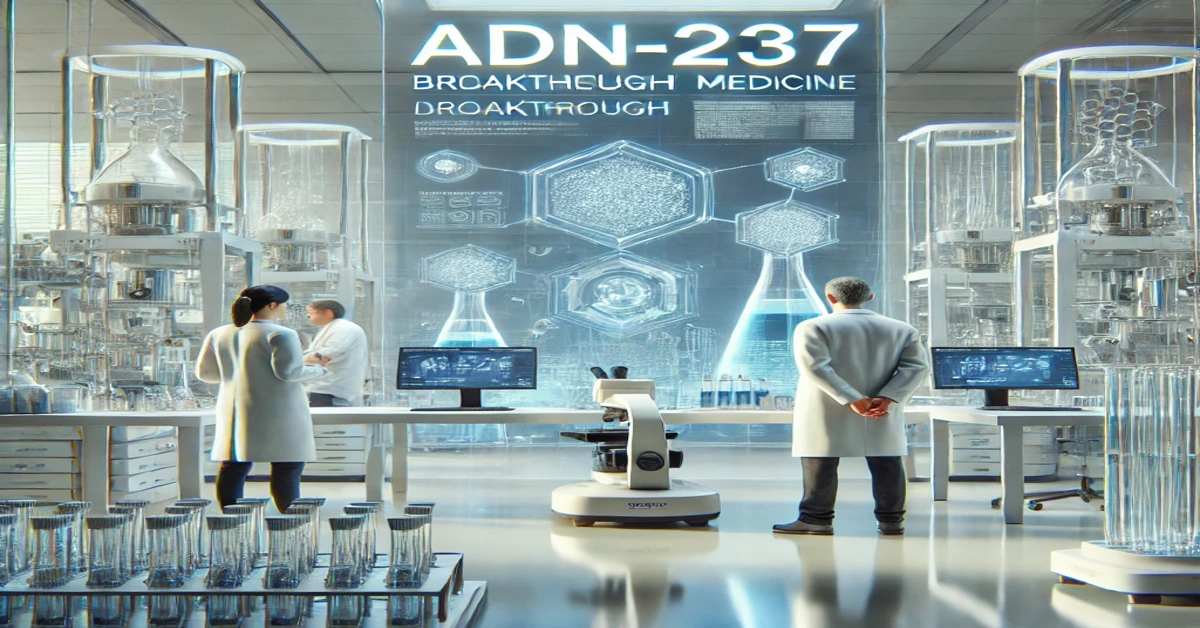ADN-237 has been generating a lot of excitement in the scientific and medical communities, and for good reason. This new compound, a synthetic polymeric complex, is designed to influence biological systems in ways that could transform the treatment of several challenging diseases. But what exactly is ADN-237, and why is it making such waves in the field of biotechnology? In this article, we’ll delve into the fascinating story of ADN-237’s creation, its purpose, and the immense collaborative effort that brought it to life.
The Promise of ADN-237: A New Era in Therapeutics
ADN-237 isn’t just another pharmaceutical compound; it’s the result of years of research aimed at crafting a substance capable of targeted therapeutic action. As a synthetic polymeric complex, ADN-237 stands apart from traditional drugs, promising a more sophisticated approach to influencing biological activities within the body. But what does this mean in practical terms? Essentially, ADN-237’s design allows it to interact with specific cellular processes to trigger desired effects, potentially leading to more effective treatments with fewer side effects.
Unlike conventional drugs that often act broadly, ADN-237 is designed with precision in mind, targeting specific pathways to maximize therapeutic benefits. This capability could be pivotal in treating diseases that have previously been difficult to address effectively, offering hope to patients and physicians alike.
The Global Collaboration Behind ADN-237’s Development
One of the most remarkable aspects of ADN-237’s journey is the international collaboration that made it possible. This compound’s development wasn’t confined to a single laboratory or country; instead, it brought together experts from around the globe, combining their expertise, resources, and unique perspectives.
Researchers from multiple fields—chemistry, biology, pharmacology, and biotechnology—worked side by side to develop and refine ADN-237. This diverse collaboration not only accelerated ADN-237’s progress but also enhanced its design, incorporating a range of insights and innovations that made the compound more versatile and effective. The journey from concept to viable pharmaceutical solution exemplifies the power of collective scientific effort in the modern era.
The Science Behind ADN-237: What Makes It Unique?
ADN-237 is a synthetic polymeric complex, a classification that indicates its sophisticated structure and functionality. But what exactly does this mean? Synthetic polymers are long chains of molecules engineered to interact with specific biological targets. This structural design allows ADN-237 to carry out precise tasks within the body, triggering certain biological responses while minimizing unintended interactions.
In practical terms, this means that ADN-237 can be tailored to influence particular cellular activities or pathways, which is especially useful in treating diseases where targeted intervention is crucial. For example, some diseases require that a drug reach a particular cell type without affecting neighboring cells. ADN-237’s synthetic polymeric structure makes such specificity possible, positioning it as a promising option for complex medical challenges.
What Diseases Could ADN-237 Potentially Treat?
While research on ADN-237 is still ongoing, early findings suggest its potential application in treating a range of diseases, particularly those that involve complex cellular processes. This includes autoimmune disorders, neurological conditions, and some types of cancer. The precise nature of ADN-237’s action makes it particularly attractive for these conditions, as it may offer a means to intervene in ways that were previously too difficult to achieve.
One of the most exciting aspects of ADN-237 is its adaptability. Because it can be modified to target specific biological activities, ADN-237 has the potential to be customized for different therapeutic purposes. This opens up possibilities not only for treating diseases that currently have few options but also for refining treatments for conditions that are already managed with existing medications, potentially offering improved outcomes.
How ADN-237 Could Revolutionize the Future of Medicine
ADN-237’s innovative design represents more than just a new drug; it symbolizes a shift in how pharmaceutical research approaches disease treatment. Traditional pharmaceuticals typically rely on broader approaches, often targeting a wide range of biological activities to achieve a therapeutic effect. While effective in many cases, this approach can sometimes lead to side effects or limited efficacy for certain conditions.
ADN-237’s targeted functionality could change this paradigm. With the potential to hone in on specific biological processes, it may offer treatments that are not only more effective but also safer, with a reduced likelihood of unintended effects. For patients, this could mean better health outcomes, faster recovery, and a greater quality of life.
The Challenges and Milestones in ADN-237’s Development
The journey to develop ADN-237 has been anything but straightforward. From the initial concept to the creation of a viable compound, researchers have faced a series of challenges and milestones that have tested their resolve and creativity. Developing a synthetic polymeric complex like ADN-237 requires not only an understanding of its potential therapeutic applications but also extensive testing and refinement to ensure its safety and efficacy.
One of the primary challenges has been ensuring that ADN-237 is stable and effective when administered to patients. To address this, researchers have conducted numerous tests to refine the compound’s structure, optimize its delivery mechanism, and ensure it meets rigorous safety standards. These efforts reflect the intense dedication of the scientific community to overcoming obstacles and maximizing ADN-237’s potential benefits.
The Role of Biotechnology in ADN-237’s Creation
Biotechnology has played a pivotal role in bringing ADN-237 from an idea to a tangible compound with real-world applications. Advances in biotechnology have enabled scientists to design, synthesize, and test complex molecules with greater precision than ever before, opening up new possibilities for pharmaceutical innovation.
In the case of ADN-237, biotechnology has been essential in creating a compound that is not only effective but also adaptable. This adaptability is one of ADN-237’s key strengths, as it allows the compound to be modified to address different diseases and conditions. Without the tools and techniques provided by modern biotechnology, such a sophisticated solution would not have been possible.
The Future of ADN-237: What Lies Ahead?
While ADN-237 has shown great promise in preclinical studies, its journey is far from over. Clinical trials are the next crucial step, during which researchers will evaluate ADN-237’s effects in human subjects. These trials will provide essential insights into the compound’s safety, efficacy, and potential for widespread use.
If successful, ADN-237 could mark the beginning of a new era in pharmaceuticals, characterized by highly targeted treatments designed to address specific biological functions. This could lead to a revolution in how we approach a variety of complex diseases, offering hope to millions of patients around the world.
Why Global Collaboration is Key to Future Innovations
The story of ADN-237 is a testament to what can be achieved when scientists, researchers, and institutions from different countries work together toward a common goal. Global collaboration has enabled the pooling of resources, expertise, and ideas, creating a fertile environment for innovation and discovery.
In the future, the lessons learned from ADN-237’s development could serve as a model for other ambitious pharmaceutical projects. By working together across borders, the scientific community can accelerate the discovery and development of new treatments, bringing hope to those who need it most.
Conclusion: ADN-237’s Potential Impact on Healthcare
ADN-237 represents a bold step forward in the field of pharmaceuticals. Its unique design as a synthetic polymeric complex offers the potential to treat diseases in ways that were previously out of reach. By influencing specific biological activities, ADN-237 promises not only to improve the effectiveness of treatment but also to reduce the side effects that often accompany conventional drugs.
As clinical trials continue and research progresses, ADN-237 holds the promise of transforming the way we approach disease treatment, offering a glimpse into a future where highly targeted and effective therapies are the norm. The journey of ADN-237 from concept to reality showcases the power of scientific innovation and global collaboration, reminding us of the incredible possibilities that await in the world of modern medicine.











